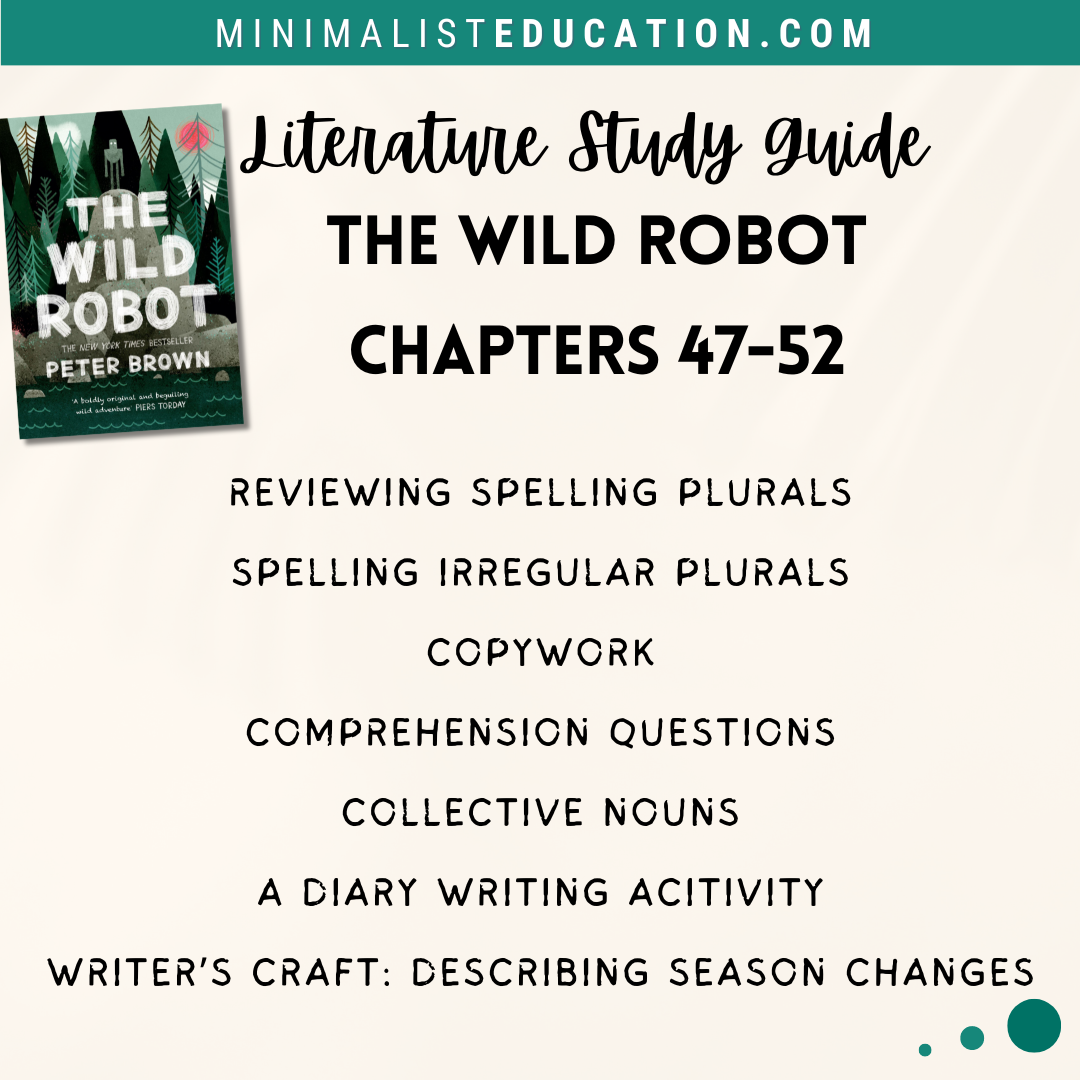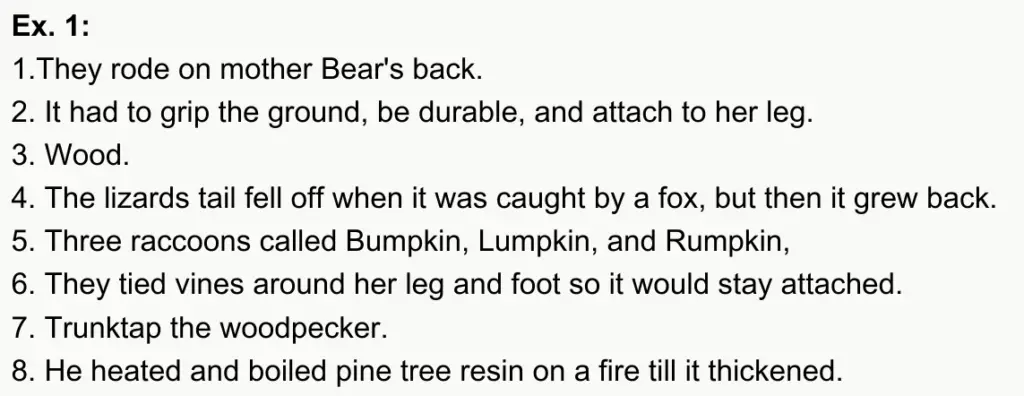Irregular Nouns: The Wild Robot Chapters 47-52 Study Guide
This post contains paid links. I may get a commission if you decide to make a purchase through my links, at no extra cost to you. Thank you for helping towards the cost of hosting and maintaining this website.

Spelling plurals of irregular nouns, copywork, comprehension questions, collective nouns, a diary writing activity, and descriptions of season changes. This is what you can expect in this weeks The Wild Robot literature study guide based on Chapters 47- 52.
Welcome to the ninth week of The Wild Robot Literature Study Guide.
You can access all of The Wild Robot weekly study guides here.
Get your copy of The Wild Robot
Buy a copy of “The Wild Robot” (Amazon Link).
In this post:
- The Wild Robot teaching notes and answers for Week 9 Chapters 47-52.
- Download The Wild Robot Study Guide for Week 9 Chapters 47-52.
The Wild Robot Chapters 47-52 Study Guide Teaching Notes And Answers
Chapters 47-48
- Read Chapters 47- 48 of The Wild Robot then answer the comprehension questions.
In this exercise, focusing on chapters 47 and 48 of The Wild Robot, we are going to dive straight into practising comprehension skills. These chapters are filled with lots details and introduce new characters, so be prepared to refer back to the text, if needed, to be able to fully respond to the questions.

Spelling: Irregular Nouns
Our spelling focus this week are nouns that defy the usual pluralisation rules.
- Read the extract and accompanying spelling notes.
They made quite a grand procession, all walking together like that. And the procession became even grander as deer and raccoons and birds and all kinds of other animals joined in. Chapter 47 page 145
Your kids probably already know that adding ‘s’ or ‘es’ is a common way to make a noun plural. However, I’ve added some notes just to recap those rules:
Making Regular Nouns Plural:
- Most Nouns: Add ‘s’ to the singular form.
Example: cat → cats
- Nouns Ending in -s, -x, -z, -sh, -ch: Add ‘es’ to the singular form.
Example: box → boxes
- Nouns Ending in a consonant and y: Change the ‘y’ to ‘i’ and add ‘es.’
Example: city → cities
- Nouns ending in -f or -fe: Change the ‘f’ or the ‘fe’ to ‘ves’.
Example: loaf → loaves
Example: knife → knives
Have a closer look at the plural nouns in this extract with your kids: racoons, birds, animals and deer. This extract includes examples of both regular plurals (processions, raccoons, birds) and an irregular plural (deer):
“raccoons” is the plural of “raccoon”, “birds” is the plural of “bird” and “animals” is the plural of “animal”. These are examples of regular plurals.
Making Irregular Nouns Plural:
The noun “deer” remains “deer”, even when it is plural! “Deer” is an example of an irregular plural. Some nouns have irregular plural forms that do not follow any rules. Other examples are “men”, the plural of “man”, and “mice”, the plural of “mouse”.
- Ex. 2 Copy the passage in your best handwriting.
- Ex. 3 Change the underlined noun to a plural noun in the sentences given.

Chapter 49
Vocabulary: Collective Nouns
- Read the extract given.
The goslings thought he was amazing. Each morning a gaggle of them would wait on the water for Brightbill to lead them into the sky. Chapter 49 page 155
What would wait on the water for Brightbill?
A gaggle. What is a gaggle?!
A gaggle is a collective noun. This is a word that represents a group of people, animals, or things.
Different groups have specific collective nouns. For instance, a group of geese is called a gaggle, while a group of owls is called a parliament.
Collective nouns often have imaginative qualities so they add a layer of creativity to language. The phrase “a gaggle of geese” is an example of a collective noun used to describe a group of geese. When Peter Brown uses the word “gaggle” in his story, it conjures up images of disorderly and noisy geese helping us to picture the scene better.
Here are some other examples of collective nouns:
A herd of cattle.
A flock of birds.
A swarm of bees.
A pack of wolves.
A school of fish.
A parliament of owls.
A murder of crows.
A pride of lions.
- Pick three collective nouns and make sentences with them. Draw a picture to go with the sentences.
Chapter 50
Writing Activity: Diary Entry
- Read Chapter 50 of The Wild Robot.
In this chapter, Brightbill, who we know to be extremely curious, turns off Roz, as both Roz and Brightbill wanted to see what would happen. When Roz powers down, Brightbill becomes frightened and quickly turns her back on.
- Write a diary entry as if you are Brightbill.
In this exercise your children will be writing a diary entry from the perspective of Brightbill, focusing on character voice, emotions, and experiences.
As they write from Brightbill’s point of view, have them think about how Brightbill might have felt before, during, and after turning off Roz. What kind of emotions did he feel? Curiosity, fear, regret?
Here’s a checklist you can use with your child as they write to help them really convey Brightbill’s perspective:
Content and structure:
- Does the diary entry include detailed descriptions of events, thoughts, and emotions?
- Are the experiences or events recounted in chronological order or organised logically?
- Are paragraphs used to separate different thoughts or events?
- Does the entry have a clear beginning, middle, and end?
Language and Style:
- Does the writing feel authentic and genuine?
- Does the diary entry convey the writer’s emotions effectively?
- Does the writing show understanding of Brightbill’s perspective?
- Does the writing use descriptive language and varying sentence structures?
- Does the entry use appropriate vocabulary for the intended audience and context?
- Are grammar, punctuation, and spelling accurate?
- Is the voice consistent throughout the diary entry?
Chapters 51-50
Writers Craft: Description
- Read Chapters 51-52 of “The Wild Robot” then write down the changes in autumn.
This chapter is full of beautiful descriptions of the changing of the season from autumn to winter. This exercise will really get your child to become aware of how detailed descriptions add to the authenticity of a narrative.

Download Your Copy of The Wild Robot Study Guide for Chapters 47-52:
I hope this helps some of you out!
Leave a Reply